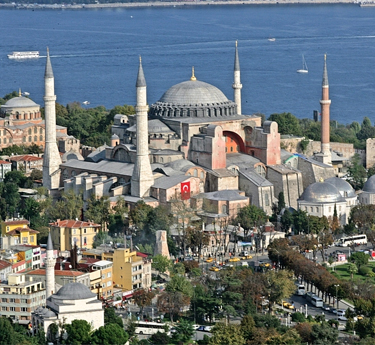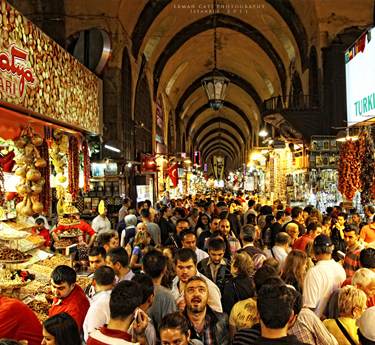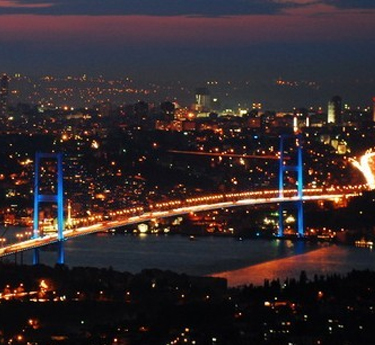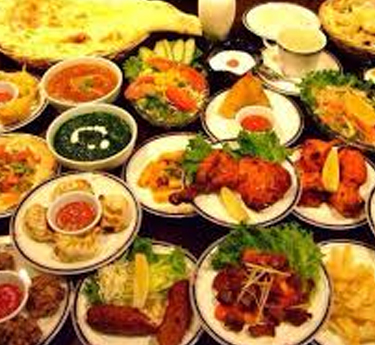Home > Istanbul Experince
Byzantium Istanbul
We'll start our day with Hagia Sophia, served Christian faith for a thousand years, Islam for five hundred years, and has been dedicated to visitors as a museum for 75 years...
Afterwords, we'll proceed to 6th C. Basilica cistern. This magnificent water reservoir houses columns from antiquity.
Local lunch will be followed by Chora Church in this tranquil neighborhood of Edirnekapı, houses one of the most beautiful examples of 12th C. Byzantine mosaics
Prices Questions
+90 216 422 43 00
+90 216 422 43 00
Istanbul: History and Summary
A city of prime importance throughout time, Istanbul is the largest city in Turkey, with a population of 17 million people (and only growing more). It is one of the only cities in the world to stretch over two continents. Whether you are on the Asian or European side of it, the city’s charm will enthrall you.
This city’s roots lie in ancient Greece, as it was settled by Greeks and called Byzantium. Located on the Bosporus just south of the Black Sea, it was an excellent spot for traders from the North, South, East, and West.
In the 300s AD, the Roman Emperor Constantine chose here as the new capital of his Empire; hereafter, it was called Constantinople, and served as the capital of the Romans and the subsequent Byzantine Empire. As the Byzantines were proud Christians, Constantinople was the center of the Christian faith for a thousand years.
In 1453, the Ottomans Turks conquered Constantinople. They converted the city into the capital of their Muslim Empire, hence why to this day you find mosques in every direction you turn. It was their capital until the Ottoman Empire’s defeat and deposition after World War I. As part of the adjustment from Empire to nation-state, the new Turkish republic moved the capital out of Istanbul; it was replaced by Ankara. Since then, Istanbul has continued to be the largest city in Turkey and is adored by its citizens.
Istanbul contains endless attractions from the Greek, Byzantine, and Ottoman times, displayed in the art and architecture preserved across the city. On our tour, you will encounter the excellently maintained churches, mosques, and other structures that transcend time and remain wonders to this day. But we won’t stay in the past for too long; we will also expose you to contemporary Istanbul, the cosmopolitan centers, and opportunities for shopping and fun…Istanbul-style.
1st Day : Byzantium Istanbul
We'll start in Sultanahmet, an area in what we call “The Old City.” We’ll see the Byzantine Hippodrome, which functioned as the forum in Byzantine times.
We will also experience the Hagia Sophia, a 1500-year-old structure that functioned as a Christian Cathedral for a thousand years. In 1453, it was converted into a mosque and served Islam for five hundred years. Since 1935, it has been a museum open to visitors. You can see Christianity and Islam coexisting inside.
Afterwards, we'll proceed to 6th C. Basilica cistern. This magnificent underground water reservoir contains columns from antiquity and sculptures of mythology.
Local lunch will be followed by Chora Church, built in Byzantine times. This small church in this tranquil neighborhood of Edirnekapı holds one of the most beautiful examples of a Byzantine mosaic.
2nd Day : Ottoman Heritage
We'll start our day with the Blue Mosque and explore its 17th C. Iznik tiles. This mosque, with its 6 minarets, is one of the best examples of Islamic Architecture. It was built to compete with the Hagia Sophia and also draws influence from it. Ladies, bring a scarf for your head!
We will then proceed to the Topkapı Palace, which inspired Mozart to compose "The Abduction From the Seraglio.” Millions watched Melina Mercouri in the film "Topkapi" and learned about the famous dagger. This palace was where the Ottomans sultans lived and ruled for over 400 years. We will see the sultans’ bedroom, council rooms, library, courtyards, and more. Additionally, we'll wander through the maze of the Harem and learn stories of the eunuchs and concubines. We will also see the Weapons and Relics rooms, which house relics, possessions, and weapons of influential figures in history. Here, you’ll see the Prophet Mohammad’s swords and clothes, Ottoman armor, possessions of Abraham, and other incredible items that will bring you closer to the past. You will learn a great deal about Islam and its role in the Ottoman Empire in the process.
Our lunch will be in the palace gardens overlooking the Bosporus.
Dinner on your own
3rd Day : Bosporus Expedition
We'll take a public ferry along the Bosporus, cruise till the very end of it closer to the Black Sea, explore an old fishing village where we will have lunch, and cruise back to the old city.
After our cruise, we can do what you’d like. We can ferry over to the Asian side of Istanbul and spend the night in Asia, or we can frolic through contemporary Istanbul. Your choice, depending on what you feel!
Dinner on your own.
4th Day : 15th C. Shopping Malls of Istanbul
Today, we'll fly by the seat of our pants and get lost in the back streets of the Old Town of Sultanahmet. While here, we’ll shop until we drop in the Grand Bazaar, a 15th C. mall of 3000 shops. Vendors will try and sell you everything from porcelain to rugs to shirts to jewelry. It’s like a maze, but the thrill of shopping here is incredible. Finding our way to the Spice market, you will experience the largest local textile district of Mahmutpaşa.
We'll than visit Rüstem Paşa Mosque built by Architect Sinan, the most prominent Ottoman architect. We’ll also have an optional visit to Süleymaniye Mosque, the largest mosque in Istanbul commissioned by Ottoman Sultan Suleiman the Magnificent.
Dinner on your own.
5th day: Contemporary Istanbul
Let’s explore the modern face of Istanbul, its fashion centers and downtown. While most things you stumble upon are most likely hundreds of years old, Istanbul is a thriving modern metropolis as well.
A Dolmabahçe Palace visit is suggested. This is the last, most modern Ottoman palace. Call it the Versailles of Istanbul, as you can see the French and 19th C. Western European influence here. It also contains the 2nd largest chandelier in the world, and is where President Mustafa Kemal Atatürk lived until his death.
In the afternoon, we'll stroll around Pera and Galata districts, which house 18th c. architecture of the late Ottoman Era. This is also a historically European section of Istanbul. You’ll witness the Galata Tower, a structure standing since the 1300s, as well as great local music opportunities.
Of course, we can play around with our schedule and adjust it as you’d like
For clarification, explanations of sites, and more, please view our Facts & FAQs tab.
You can also email us at [email protected]
We'll start in Sultanahmet, an area in what we call “The Old City.” We’ll see the Byzantine Hippodrome, which functioned as the forum in Byzantine times.
We will also experience the Hagia Sophia, a 1500-year-old structure that functioned as a Christian Cathedral for a thousand years. In 1453, it was converted into a mosque and served Islam for five hundred years. Since 1935, it has been a museum open to visitors. You can see Christianity and Islam coexisting inside.
Afterwards, we'll proceed to 6th C. Basilica cistern. This magnificent underground water reservoir contains columns from antiquity and sculptures of mythology.
Local lunch will be followed by Chora Church, built in Byzantine times. This small church in this tranquil neighborhood of Edirnekapı holds one of the most beautiful examples of a Byzantine mosaic.
2nd Day : Ottoman Heritage
We'll start our day with the Blue Mosque and explore its 17th C. Iznik tiles. This mosque, with its 6 minarets, is one of the best examples of Islamic Architecture. It was built to compete with the Hagia Sophia and also draws influence from it. Ladies, bring a scarf for your head!
We will then proceed to the Topkapı Palace, which inspired Mozart to compose "The Abduction From the Seraglio.” Millions watched Melina Mercouri in the film "Topkapi" and learned about the famous dagger. This palace was where the Ottomans sultans lived and ruled for over 400 years. We will see the sultans’ bedroom, council rooms, library, courtyards, and more. Additionally, we'll wander through the maze of the Harem and learn stories of the eunuchs and concubines. We will also see the Weapons and Relics rooms, which house relics, possessions, and weapons of influential figures in history. Here, you’ll see the Prophet Mohammad’s swords and clothes, Ottoman armor, possessions of Abraham, and other incredible items that will bring you closer to the past. You will learn a great deal about Islam and its role in the Ottoman Empire in the process.
Our lunch will be in the palace gardens overlooking the Bosporus.
Dinner on your own
3rd Day : Bosporus Expedition
We'll take a public ferry along the Bosporus, cruise till the very end of it closer to the Black Sea, explore an old fishing village where we will have lunch, and cruise back to the old city.
After our cruise, we can do what you’d like. We can ferry over to the Asian side of Istanbul and spend the night in Asia, or we can frolic through contemporary Istanbul. Your choice, depending on what you feel!
Dinner on your own.
4th Day : 15th C. Shopping Malls of Istanbul
Today, we'll fly by the seat of our pants and get lost in the back streets of the Old Town of Sultanahmet. While here, we’ll shop until we drop in the Grand Bazaar, a 15th C. mall of 3000 shops. Vendors will try and sell you everything from porcelain to rugs to shirts to jewelry. It’s like a maze, but the thrill of shopping here is incredible. Finding our way to the Spice market, you will experience the largest local textile district of Mahmutpaşa.
We'll than visit Rüstem Paşa Mosque built by Architect Sinan, the most prominent Ottoman architect. We’ll also have an optional visit to Süleymaniye Mosque, the largest mosque in Istanbul commissioned by Ottoman Sultan Suleiman the Magnificent.
Dinner on your own.
5th day: Contemporary Istanbul
Let’s explore the modern face of Istanbul, its fashion centers and downtown. While most things you stumble upon are most likely hundreds of years old, Istanbul is a thriving modern metropolis as well.
A Dolmabahçe Palace visit is suggested. This is the last, most modern Ottoman palace. Call it the Versailles of Istanbul, as you can see the French and 19th C. Western European influence here. It also contains the 2nd largest chandelier in the world, and is where President Mustafa Kemal Atatürk lived until his death.
In the afternoon, we'll stroll around Pera and Galata districts, which house 18th c. architecture of the late Ottoman Era. This is also a historically European section of Istanbul. You’ll witness the Galata Tower, a structure standing since the 1300s, as well as great local music opportunities.
Of course, we can play around with our schedule and adjust it as you’d like
For clarification, explanations of sites, and more, please view our Facts & FAQs tab.
You can also email us at [email protected]
Sites: Must-Sees:
-Hagia Sophia
-Basilica Cistern
-Chora Church
-Blue Mosque
-Topkapı Palace
-Grand Bazaar, Spice Market
-Galata Tower
Additional Sites If You’d Like:
-Dolmabahçe Palace
-Suleymaniye Mosque
-Istanbul Naval Museum
-Istanbul Archaeological Museum
-Barbarossa’s Mausoleum (only open on Fridays!)
-Rumeli Hisar
-Byzantine Walls
-Istanbul Modern
.
-Hagia Sophia
-Basilica Cistern
-Chora Church
-Blue Mosque
-Topkapı Palace
-Grand Bazaar, Spice Market
-Galata Tower
Additional Sites If You’d Like:
-Dolmabahçe Palace
-Suleymaniye Mosque
-Istanbul Naval Museum
-Istanbul Archaeological Museum
-Barbarossa’s Mausoleum (only open on Fridays!)
-Rumeli Hisar
-Byzantine Walls
-Istanbul Modern
.
Food in Turkey
Baklava,
Gözleme,
Fish,
Rakı,
Döner...
Baklava,
Gözleme,
Fish,
Rakı,
Döner...
Facts & FAQs
-this tab covers cultural norms, recommendations on what to bring, explanation of sites, and further explanations of Istanbul
Istanbul is a magical city whose mysteries, histories, and charm dazzle all of its citizens and visitors. Although most things you stumble upon are probably hundreds of years old, it is a thriving, modern metropolis, with skyscrapers, billboards, and a subway system. Unlike most cities, though, it doesn’t exactly have a center of town, but rather contains many small neighborhoods that collectively make Istanbul what it is. It also has three bodies of water (the Sea of Marmara, the Bosporus, and the Golden Horn), so there will be plenty of opportunities to walk along it and take a pleasant boat ride between the two continents.
It is also home to so many different types of people. You’ll see all kinds here: Middle Easterners, Turks, Africans, Asians, Westerners, etc. You will hear and see English, as many people know a few words here and there. If you’re interested, please refer to the Survival Turkish tab to get a sense of what words you’ll hear. It can’t hurt!
A few things to keep in mind:
1. Istanbul is one of the safest cities in Europe. People are friendly, honest, hilarious, and welcoming. The politics are absolutely stable.
2. You will see pictures of a very special, particular man all across town: in public places, restaurants, and any other establishment. You’ll also see his signature on windows, car bumpers, and more places. That man is Mustafa Kemal Ataturk, the first president of the Turkish Republic. He is the most celebrated figure in Turkish history, and the Turks take great pride in the work he did to make the nation what it is. His last name, Ataturk, literally means “Father of the Turks,” or “First Turk.”
3. Religion: Although secular since 1923, Islam can be felt all over the city. You will see a mosque in almost every direction you turn. Many women choose to wear the hijab, a veil that covers the head and neck, and many people dress conservatively. In mosques, all women are required to wear a scarf over their head, so when we visit a mosque or two, ladies bring one along!
4. You will hear the Call to Prayer several times throughout the day. Practicing Muslims pray five times a day. To bring the community together, an official called a muezzin sings a gorgeous melody from the mosque that reminds everyone it is time to pray. It’s always such a pleasure to hear, as it makes you feel a part of their community.
5. It is a densely populated city, so be prepared for large crowds!
6. People are incredibly kind here. It’s part of what they call the “Turkish hospitality.” People will take care of you well at restaurants and in hotels.
7. In the Grand Bazaar, many vendors speak English, but for a product, they often start with a high asking price. We’ll help you out with talking them down though
8. For public transportation, Istanbul has an organized bus system, tram route, and ferries between the Asian and European side. There are also taxis (spelled taksi), but the traffic is busy!
9. You will drink a lot of tea (called çay (pronounced like chai) here), so be prepared. Çay is a national drink, and you will see it everywhere in these curvy glasses; we here have drank çay out of these since Ottoman times.
10. Cats and dogs roam around the streets. They are treated like family. It is okay to pet and feed them. Many have tags behind their ears indicating that they have been vaccinated.
11. For information about food, please refer to our Accommodations & Dining Tab, or scroll to the ABOUT TURKEY section of our website.
12. If you have additional questions, please contact us at [email protected]
-this tab covers cultural norms, recommendations on what to bring, explanation of sites, and further explanations of Istanbul
Istanbul is a magical city whose mysteries, histories, and charm dazzle all of its citizens and visitors. Although most things you stumble upon are probably hundreds of years old, it is a thriving, modern metropolis, with skyscrapers, billboards, and a subway system. Unlike most cities, though, it doesn’t exactly have a center of town, but rather contains many small neighborhoods that collectively make Istanbul what it is. It also has three bodies of water (the Sea of Marmara, the Bosporus, and the Golden Horn), so there will be plenty of opportunities to walk along it and take a pleasant boat ride between the two continents.
It is also home to so many different types of people. You’ll see all kinds here: Middle Easterners, Turks, Africans, Asians, Westerners, etc. You will hear and see English, as many people know a few words here and there. If you’re interested, please refer to the Survival Turkish tab to get a sense of what words you’ll hear. It can’t hurt!
A few things to keep in mind:
1. Istanbul is one of the safest cities in Europe. People are friendly, honest, hilarious, and welcoming. The politics are absolutely stable.
2. You will see pictures of a very special, particular man all across town: in public places, restaurants, and any other establishment. You’ll also see his signature on windows, car bumpers, and more places. That man is Mustafa Kemal Ataturk, the first president of the Turkish Republic. He is the most celebrated figure in Turkish history, and the Turks take great pride in the work he did to make the nation what it is. His last name, Ataturk, literally means “Father of the Turks,” or “First Turk.”
3. Religion: Although secular since 1923, Islam can be felt all over the city. You will see a mosque in almost every direction you turn. Many women choose to wear the hijab, a veil that covers the head and neck, and many people dress conservatively. In mosques, all women are required to wear a scarf over their head, so when we visit a mosque or two, ladies bring one along!
4. You will hear the Call to Prayer several times throughout the day. Practicing Muslims pray five times a day. To bring the community together, an official called a muezzin sings a gorgeous melody from the mosque that reminds everyone it is time to pray. It’s always such a pleasure to hear, as it makes you feel a part of their community.
5. It is a densely populated city, so be prepared for large crowds!
6. People are incredibly kind here. It’s part of what they call the “Turkish hospitality.” People will take care of you well at restaurants and in hotels.
7. In the Grand Bazaar, many vendors speak English, but for a product, they often start with a high asking price. We’ll help you out with talking them down though
8. For public transportation, Istanbul has an organized bus system, tram route, and ferries between the Asian and European side. There are also taxis (spelled taksi), but the traffic is busy!
9. You will drink a lot of tea (called çay (pronounced like chai) here), so be prepared. Çay is a national drink, and you will see it everywhere in these curvy glasses; we here have drank çay out of these since Ottoman times.
10. Cats and dogs roam around the streets. They are treated like family. It is okay to pet and feed them. Many have tags behind their ears indicating that they have been vaccinated.
11. For information about food, please refer to our Accommodations & Dining Tab, or scroll to the ABOUT TURKEY section of our website.
12. If you have additional questions, please contact us at [email protected]


















